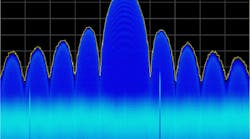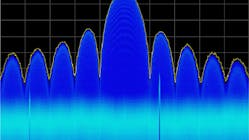Meeting complex spectrum emissions standards requires test solutions that can effectively perform intermodulation distortion (IMD) and RF interference measurements. The signal analyzer lies at the heart of many of these test solutions. In the application brief, “Measuring Intermodulation Distortion and RF Interference,” Keysight Technologies explains how to select and optimize a signal analyzer to meet spectrum emissions standards.
The brief lists three steps that should be followed when making compliance-based spectrum emissions measurements. The first step is to simply select the correct signal analyzer. Modern signal analyzers can accommodate the complexity associated with today’s signals and wireless standards. Specifically, the latest signal analyzers possess a great deal of signal processing power and computational capabilities.
Another key aspect is to have wide digitizing bandwidths. Ultimately, the measurement capabilities of modern signal analyzers range from basic spectrum measurements to advanced digital demodulation. In addition, software simplifies measurement setup and improves speed.
For wireless spectrum emissions measurements, one must consider a number of parameters. These include spurious-free dynamic range (SFDR), IMD, frequency range, and sensitivity. In addition, measurement applications must accommodate the standards of interest. Analysis bandwidth can also be significant in terms of making fast adjacent-channel-power-ratio (ACPR) measurements, as well as locating time-varying spurious emissions.
The second step is to optimize the signal analyzer—correctly setting its attenuation value, for instance. Furthermore, when selecting the resolution bandwidth (RBW), it should allow for a sufficient displayed average noise level (DANL). The signal analyzer’s noise floor can be improved through other methods that include utilizing internal or external preamplification. On top of that, advanced signal processing technology can help enhance signal-analyzer performance.
The final step involves finding and measuring time-varying spurious and RF interference signals. Real-time spectrum-analysis (RTSA) capability enables signal analyzers to discover and measure these signals. With RTSA, thousands of overlapping spectra can be calculated each second, thereby capturing the shortest transient events. The application brief wraps up with a description of Keysight’s MXA X-Series signal analyzer.
Keysight Technologies, 1400 Fountaingrove Pkwy., Santa Rosa, CA 95403; (707) 577-2663; www.keysight.com.


